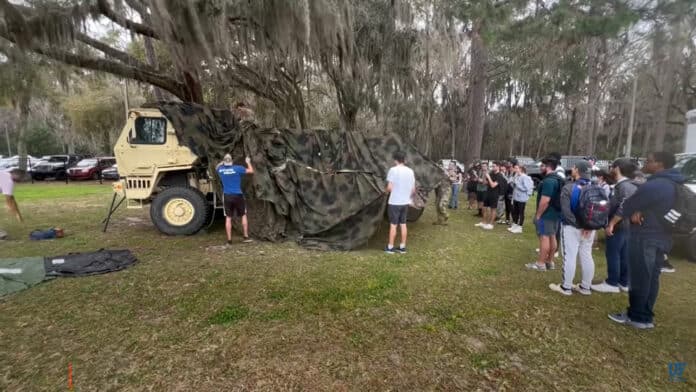A class project for senior engineering students at the University of Florida turned into a practical solution for soldiers who needed an easier, faster, and safer way to camouflage their vehicles on the battlefield.
The project involved partnering with Georgia Institute of Technology and the Civil-Military Innovation Institute (CMI2) to design and produce a vehicle camouflage deployer for the U.S. Army 3rd Infantry Division. Students from Matthew J. Traum’s mechanical engineering capstone course received real-world training and contribute to the safety and efficiency of the military.
Traum said a prototype of the UF-designed vehicle camouflage deployment device was delivered to Fort Stewart at the end of the fall 2023 semester and replicated in-house by the Army. The device is currently being field tested.
“The Army’s tactical innovation labs play a key role in addressing in-field challenges faced by frontline soldiers and securing the necessary resources and technologies to resolve them,” said Emert, the CMI2 lab manager for the Marne Innovation Center at Fort Stewart. “We source problems directly from service members and engage engineering students in a short cycle of product development.”
The military faced a challenge in the deployment of combat vehicles on the battlefield. According to Captain Chris Aliperti, the soldiers need a solution that could help them save time and ensure their safety when covering the vehicles with camouflage material to hide them from the enemy.

As a result, the Marne Innovation Center had a project for senior engineering students, who were tasked to design and build a solution that could potentially solve the problem within a year.
“This was something soldiers on the frontline were asking for, and our team didn’t have the bandwidth to address it,” Aliperti said. “The collaboration with the University of Florida provided invaluable hands-on experience to their students, and the end result contributes directly to enhancing the capabilities of our service members.”
The Army project spanned three semesters and had a large enrollment of 80 students each semester. The soldiers were involved in the project and were able to offer input and ideas to the students on a weekly basis.
“It was interesting to see how the design started out as something most people would come up with, but after students met with the soldiers, took their feedback, and ran analyses, they ended up with something that looked very different,” Aliperti said. “And it solves the problem much better than the original design.”
The students’ innovation addressed a persistent issue faced by soldiers. As per the traditional method, the poles used to hold up the camouflage material were staked into the ground, which proved to be quite challenging in muddy terrain or urban concrete areas. However, the students have come up with a solution that utilizes mounting plates that can be secured into place by the vehicle’s weight.
According to Traum, this novel feature has caught the Army’s attention as it eliminates the dependence on ground conditions and provides an adaptable solution.
In addition, the new device can hide the type of vehicle under the camouflage netting by strategically deploying poles to disrupt the shape of the netting and vary the vehicle’s silhouette each time it is deployed. This will make it harder for the enemy to identify the concealed asset. The device was developed by students who used the same poles and net but made them much more efficient. This successful project has set a precedent for future collaborations between academia and the military.
“Bringing ideas of this scope and scale to students to chew on allows young engineers to apply the fundamental lessons they learn in a book to real-life problems,” Aliperti said. “And if we strike gold on a great design like this one from the University of Florida, we’ve made a monumental impact across the entire Army.”
